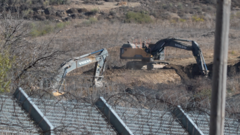
UN Raises Concerns Over Israeli Construction in Golan Heights Buffer Zone
The United Nations has reported “severe violations” of a 50-year-old ceasefire agreement along the border between Israel and Syria in the occupied Golan Heights. Satellite photographs and BBC footage reveal new trenches and earth berms constructed in recent months along the Area of Separation (AoS), a demilitarized buffer zone established in 1974.
The UN Disengagement Observer Force (UNDOF) reports that while most Israeli construction remains within controlled areas, some trenches do cross into the buffer zone. These trenches, approximately 6 meters (20 feet) wide, have been dug under military protection, with Israeli army vehicles and personnel entering the restricted area.
The AoS was created following Israel’s occupation of the Golan Heights, with specific lines defining Israeli and Syrian military positions. Israeli forces are required to remain west of the Alpha Line, while Syrian forces must stay east of the Bravo Line. Israel unilaterally annexed the Golan in 1981, a move not internationally recognized until the US did so in 2019.
Israeli Defense Forces (IDF) spokesman Lt Col Nadav Shoshani defended the construction, stating the trenches are designed to protect against potential infiltration by Iran-backed groups in Syria. He emphasized that the IDF is operating on Israeli territory to prevent potential terrorist invasions.
The current tensions come in the context of broader regional conflicts. Israel is already engaged with Iranian allies Hamas and Hezbollah on two borders. The threat of surprise invasion has increased since the October 7 Hamas attacks, though UNDOF Chief of Mission Bernard Lee notes the trenches would only impede ground vehicle infiltration.
The construction has raised additional concerns about potential smuggling routes. Lee revealed that commercial smugglers already use the AoS to transport goods between Syria and Lebanon, using a UN-built patrol road to facilitate their operations. This has heightened Israeli concerns about potential weapon smuggling to Hezbollah.
Syria has strongly protested the Israeli construction, and the UN has repeatedly raised concerns with Israeli military authorities. Israel has similarly complained about Syrian violations, including alleged armed presence in the separation zone.
Local residents have mixed reactions. Farhat, a Syrian hotel owner in the occupied Golan Heights, expressed both fear and a sense of security, stating, “The situation is frightening. Our eyes are looking more to the sky than to the plants.”
Despite the ongoing tensions, the Golan Heights frontier has remained relatively calm, even as Israel battles Iranian allies in Gaza and Lebanon. Syria appears reluctant to be drawn into direct conflict, despite frequent Israeli strikes targeting Hezbollah and Iranian positions in the region.
The situation highlights the ongoing complexity of border tensions in this strategically sensitive region, with both sides maintaining vigilance amid potential security threats.








